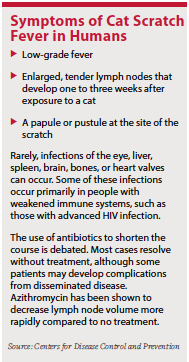Q: Could you help me with some accurate information on Bartonella in cats? I recently found a cat that has dental disease. She had to have three teeth pulled. Her age is estimated between 3 and 6 years of age.
Due to the condition of her teeth, I had her tested for Bartonella and she tested positive. My veterinarian has prescribed azithromycin for a month and recheck in six months.
I have other cats, and I am concerned that either I or my cats could contract it. I have her separated from them.
She needs to be adopted out, but I want to be sure this can be done safely for her adopters.
A: Thank you for getting in touch and for your care of and concern for the cat. I understand your worries very much, and I hope that a brief review of feline bartonellosis will be helpful.
 Currently, 22 species of Bartonella have been identified, and all inhabit the red blood cells of cats that are infected. The most common species in cats is Bartonella henselae, and cats (and people) most commonly become infected via scratch wounds from other cats that have the feces of infected fleas embedded in their nails, which occurs when grooming.
Currently, 22 species of Bartonella have been identified, and all inhabit the red blood cells of cats that are infected. The most common species in cats is Bartonella henselae, and cats (and people) most commonly become infected via scratch wounds from other cats that have the feces of infected fleas embedded in their nails, which occurs when grooming.
Most cats that become infected with Bartonella do not exhibit any symptoms, and the prevalence of infection among feline populations can be quite high depending upon geographic location. In rare cases when cats become ill as a result of infection, they may suffer from fever and an inflammatory syndrome that can damage the heart, liver, lungs, kidney, and central nervous system.
Contrary to previous belief, Bartonella species are not believed to play a significant role in chronic gingivostomatitis (inflammation of the gums and oral cavity), so it may be that the oral disease your cat is suffering from is not related to her apparent Bartonella infection. It is quite possible that her positive Bartonella status is incidental.
In cases in which Bartonella is suspected of causing disease in cats, diagnosis involves not only demonstrating that a cat is infected (remember, most feline infections are asymptomatic), but also ruling out other potential causes of disease and demonstrating improvement in symptoms with appropriate antibiotic therapy. Importantly, many cats that do respond to appropriate antibiotic therapy do not completely clear their infections.
As you correctly alluded to, cats can transmit Bartonella to people, most commonly via scratch wounds, leading to a syndrome known as “cat scratch fever.” This disease most commonly causes fever and enlargement of the lymph nodes that is self-limiting, but in some cases, it can cause more serious health problems in affected people (particularly those who are immunosuppressed), including infections of the heart, eye, and central nervous system.
Prevention of Bartonella infections in both cats and people involves assuring that cats are free of fleas (via the use of appropriate preventatives and keeping cats indoors) and keeping their nails trimmed. Prevention of human infections (zoonosis) also involves avoiding rough play with cats, making sure that immunosuppressed individuals do not adopt cats with fleas or that have unknown health status/exposure to cats of unknown health status, and immediate washing of any cat scratch or bite wounds with warm soap and water, followed by consultation with a health-care professional.
I hope this helps, and best of luck with finding this kitty a happy home.



